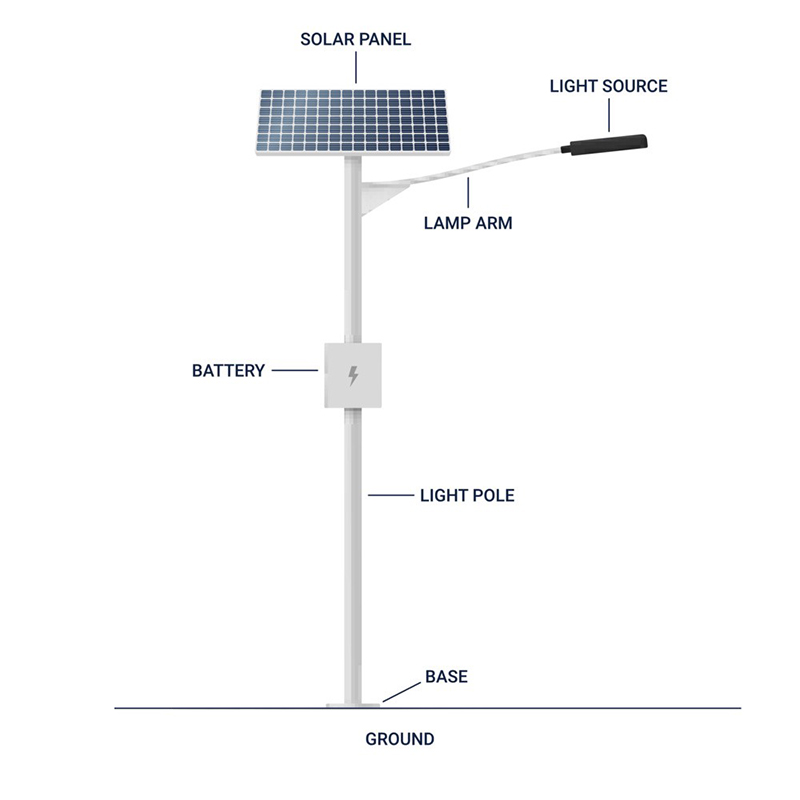Solar street lights have become an essential part of modern urban infrastructure, providing an eco-friendly and cost-effective lighting solution. These lights depend on various types of batteries to store the energy captured by solar panels during the day.
1. Solar street lights commonly use lithium iron phosphate batteries:
What is a lithium iron phosphate battery?
A lithium iron phosphate battery is a type of lithium-ion battery that uses lithium iron phosphate (LiFePO4) as the cathode material and carbon as the anode material. The nominal voltage of a single cell is 3.2V, and the charging cut-off voltage is between 3.6V and 3.65V. During charging, lithium ions detach from the lithium iron phosphate and travel through the electrolyte to the anode, embedding themselves in the carbon material. Simultaneously, electrons are released from the cathode and travel through the external circuit to the anode to maintain the balance of the chemical reaction. During discharge, lithium ions move from the anode to the cathode through the electrolyte, while electrons move from the anode to the cathode through the external circuit, providing energy to the outside world.
The lithium iron phosphate battery combines many advantages: high energy density, compact size, fast charging, durability, and good stability. However, it is also the most expensive among all batteries. It typically supports 1500-2000 deep cycle charges and can last 8-10 years under normal use. It operates within a wide temperature range of -40°C to 70°C.
2. Colloidal batteries commonly used in solar street lights:
What is a colloidal battery?
A colloidal battery is a type of lead-acid battery in which a gelling agent is added to sulfuric acid, converting the electrolyte into a gel-like state. These batteries, with their gelled electrolyte, are called colloidal batteries. Unlike conventional lead-acid batteries, colloidal batteries improve upon the electrochemical properties of the electrolyte base structure.
Colloidal batteries are maintenance-free, overcoming the frequent maintenance issues associated with lead-acid batteries. Their internal structure replaces the liquid sulfuric acid electrolyte with a gelled version, significantly enhancing power storage, discharge capacity, safety performance, and lifespan, sometimes even outperforming ternary lithium-ion batteries in terms of price. Colloidal batteries can operate within a temperature range of -40°C to 65°C, making them suitable for use in colder regions. They are also shock-resistant and can be safely used under various harsh conditions. Their service life is double or more compared to ordinary lead-acid batteries.
3. NMC lithium-ion batteries commonly used in solar street lights:
NMC lithium-ion batteries offer numerous advantages: high specific energy, compact size, and fast charging. They typically support 500-800 deep cycle charges, with a lifespan similar to colloidal batteries. Their operational temperature range is -15°C to 45°C. However, NMC lithium-ion batteries also have drawbacks, including less internal stability. If produced by unqualified manufacturers, there is a risk of explosion during overcharging or in higher temperature environments.
4. Lead-acid batteries commonly used in solar street lights:
Lead-acid batteries have electrodes composed of lead and lead oxide, with an electrolyte made of sulfuric acid solution. The key advantages of lead-acid batteries are their relatively stable voltage and low cost. However, they have a lower specific energy, resulting in larger volume compared to other batteries. Their lifespan is relatively short, generally supporting 300-500 deep cycle charges, and they require frequent maintenance. Despite these disadvantages, lead-acid batteries remain widely used in the solar street light industry due to their cost advantage.
The choice of battery for solar street lights depends on factors such as energy efficiency, lifespan, maintenance needs, and cost. Each type of battery has its unique advantages, catering to different requirements and conditions, ensuring that solar street lights remain a reliable and sustainable lighting solution.
Post time: Jul-05-2024









